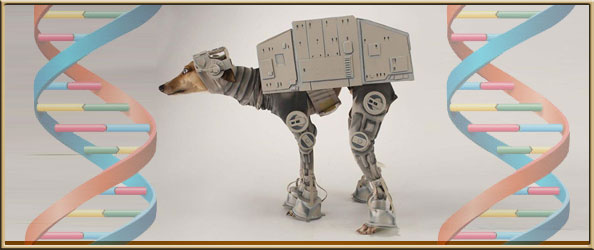The Menagerie Part 2: The Canine
[Main Image: Bones Mello, the AT-AT Dog]
As explained in my last article, we’re going to make a team of superheroes based on animals. And there’s no better place to start than with the most loyal of animals, the dog. So we’ll make a canine-like man. Yes, he’s his own best friend. But hopefully he’ll be in better shape than John Candy. And no, we’re not naming him Barfolomew.
So what would it take to make a canine hero?
Appearance
It’s hard to have a canine hero without hair. Lots and lots of hair. And I don’t simply mean that he has to be Greek. Rather, he should look like the Michael J. Fox version of Scott Howard, sans the letter jacket and sunglasses. A condition which causes such an effect is called hirsutism. Side show freaks with hirsutism were often called wolf-boy, dog-boy, or monkey-boy. However, as stated in the Introduction, people with this condition are rare. To assume one can be found who is also a good candidate for super-heroism is quite unlikely. And taking a good candidate and infusing this condition is too much of a hassle.
So we turn to the good old world of cosmetic surgery. There’s nothing like abusing the men’s hair club to produce a hairy hero. I’m sure we can have a lot of fun with micrografts, especially from donors in order to create a little variety. Give the dog-man pointed ears and a collar and you’re set.
Sense of Smell
This is one thing that we’re probably not going to pull off biologically. Biologically speaking, the size of the nose is important as it needs to hold smell receptors. The place in a dog’s nose which houses the smell receptors is about 60 times as large as a human’s. And while a human has about 5 million smell receptors, a dog can have as many as 300 million or more! In addition, the part of a dog’s brain which interprets smell is much larger than a human’s, allowing a dog to analyze smells up to 10,000 times as well as humans. While the brain can adapt to new senses and sensing devices, copying a dog’s sense of smell becomes a bit of a problem. Doesn’t that … uh … stink?
So we look to the world of technology. There are several artificial noses in development, each with its own type of chemical receptors. All of them look promising to one extent or another. Some use quartz crystals, others use chemically treated plates, and others use an artificial mucous. But all are designed to sense different molecular sizes and shapes in order to determine what is being smelled. When enough sensors are produced small enough, the potential of dog-like smell is not unlikely.
And don’t worry about whether or not the brain can handle the new sensors. The human brain has an enormous capacity to adapt to new devices. When the brain senses something new and doesn’t know what to do with the information, it begins to analyze what it senses in relation to what is going on around. This is much how a baby learns to use its own senses. So implanting a mechanical sniffer can potentially produce the smelling ability of a blood hound (or even just a Dachshund). Perhaps the brain can gain the analytic ability as well.
Night Vision
One of the things that makes a dog a good predator is it’s ability to see in the dark. This is the reason a human can trip and stumble through a dark hallway while a dog can run up the stairs and lick its master in the face when it wants to go for a walk at 2:30 in the morning. Although no known animal can see in total darkness, the canine is gifted enough to see in light so dim that a human would swear it was total darkness.
But the dog pays the price for this advantage. The first is that it has a wider pupil to let in more light and has more rods than cones on its retina. This means that while it’s not completely colorblind (contrary to popular belief), it doesn’t see color as well as a human. So if you need the dog to push the green button to save everyone and not the red one that kills everyone, there’s a 25% chance the dog will get it right (25% green, 25% red, 50% that it will simply sniff and lick the control panel before marking its territory).
The other problem is that part of it’s night vision is due to the tapetum, a reflective coating on the retina, which reflects light and gives the retina a second chance to absorb the light, just like Vin Diesel’s character Riddick. It also scatters light causing its vision to go from 20:20 to 80:20. The dog’s olfactory senses are far superior to its visual senses. That’s why a dog must sniff out an object to determine what it is when a human can simply look and see that it’s another dog’s butt.
So in order to give our hero similar night vision without all the drawbacks, we once again look toward technology. One type of artificial vision is designed for blind people. It imitates vision using sound. Unfortunately, it leaves the person completely colorblind.
The other, and most likely, method is by implanting a sensor chip onto the retina. Early tests of this technology, while not producing dazzling results, looks promising. And the ability to see would only be limited by the capabilities of the chip itself.
Heightened Hearing
Typical human hearing generally tops out at 20,000 Hz to 23,000 Hz. However, some people are able to faintly hear dog whistles. This tells me that the human brain should be able to adapt to implants or other devices which produce a higher frequency. Cochlear implants are known to give sound to deaf people. But cerebral implants would probably be more effective (though also just a bit more invasive). Perhaps then a human can gain the 45,000+ Hz that a canine can achieve.
Dogs can also hear sound which are much quieter than a human can hear. The solution to this is a no-brainer (in a proverbial sense, not a literal one). A simple hearing aid-like device which can boost sound, yet dampen louder noises, would be simple, cheap, and ideal. And best of all, the technology is immediately available, not a near-future hopeful.
So now we have our first hero, the canine. He can see better, hear crisper, and smell with greater superiority. And if he so chooses, he can even howl at the moon, or a middle finger, or any other obscene gesture. But he probably shouldn’t mark his territory in public lest he get thrown in the pound.
![]()






Reblogged this on Daniel C. Handley and commented:
Written for SciFi4Me.com